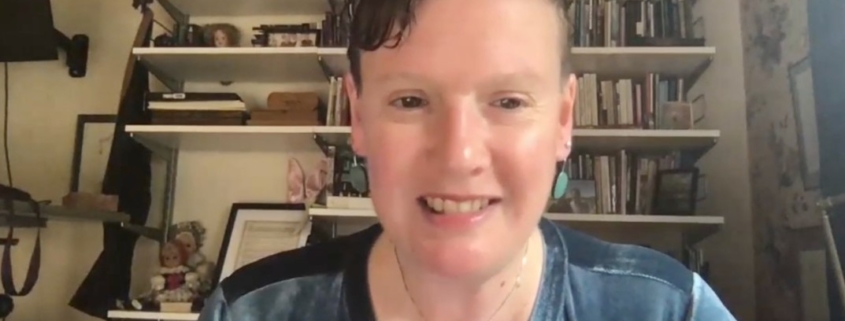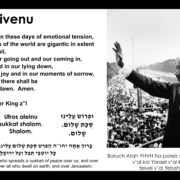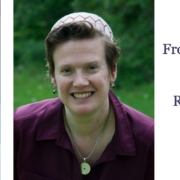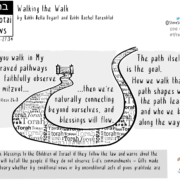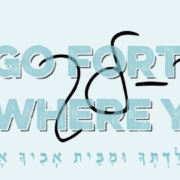Palabras del Torá / a “vort” of Torah from R’ Rachel Barenblat
Each month Bayit offers regular video “vorts” (words of Torah / teachings from Jewish tradition) offered in or translated into Spanish, designed for Cuban Jewish communities and available to Spanish-speaking Jews everywhere. This month’s video offering features a teaching from Rabbi Rachel Barenblat. The text follows the video, in Spanish and then in English. Deepest thanks to Rabbi Juan Mejia for translation.
Palabras del Torá / a “vort” of Torah from R’ Rachel Barenblat from Bayit: Building Jewish on Vimeo.
Shalom javerim. Espero que sus Altas Fiestas hayan sido dulces y significativas.
En este mes, llega la fiesta de Simjat Torá, cuyo nombre significa “la alegría de la Torá.” Cuando leemos la Torá todos los sábados, leemos todas las porciones de la Torá salvo la última, la cual se llama “Vezot Haberajá”, “ésta es la bendición.” Esta porción final de la Torá contiene la última bendición que Moisés da a los Hijos de Israel y la muerte de Moisés mismo. Esta porción no es leída en Shabbat, sino en Simjat Torá.
Y al leerla hacemos algo inesperado: pasamos inmediatamente del final de la Torá al comienzo. Pasamos de la muerte de Moises a final de Deuteronomio directamente a la creación del Cosmos al comienzo del Génesis. ¿Tal vez se pregunten por qué?
Una respuesta es que la muerte de Moisés es una historia triste. La Torá nos dice: “Nunca más se alzó un profeta como Moisés.” Moisés fue nuestro más grande profeta, y ahora se ha ido. Los sabios de nuestra tradición no querían dejarnos en la tristeza de esa pérdida. Así que nos instruyeron a seguir inmediatamente con el comienzo del Génesis. Esto nos recuerda que esa pérdida no es el final de la historia– de ninguna historia. Todo final ofrece un nuevo comienzo.
Otra respuesta es que al conectar el final de nuestra historia con el comienzo de nuestra historia aprendemos algo profundo sobre la tradición judía y sobre la Toŕa misma.
La última letra de la Torá es lamed, la cual termina la palabra Yisrael, nuestro nombre como comunidad y como pueblo. La primera letra de la Torá es la letra bet, la cual comienza la palabra Bereshit. “En el comienzo”, o “en un comienzo” o “al comenzar Dios a crear el cielo y la tierra…”
Cuando viajamos del final de la Torá al comienzo de la Torá, la última lamed y la primera bet, forman la palabra “lev”, “corazón”. El corazón de la Torá encontramos el amor.
Esta es una metáfora. ¡Y también es la simple y llana verdad! El verso que aparece en la mitad del libro medio del rollo es “amarás a tu prójimo como a ti mismo.” Esta es llamada a veces “la mitzvá del Creador”. Todas las 613 mitzvot vienen de Dios, pero esta ocupa un lugar especial en la tradición porque es, literalmente, el corazón de la Torá. Esta mitzvá evoca el acto original de creación de DIos – un acto motivado, dicen nuestros místicos, por el amor y el deseo de estar en relación con nosotros.
En Simjat Torá conectamos el final con el comienzo y encontramos “lev”: el corazón amante de la Torá.
Hay amor en nuestros finales y hay amor en nuestros comienzos. Hay amor que nos conecta con la Torá y amor que nos conecta los unos con los otros. Hay amor en nuestro ocuparnos los unos de los otros y ocuparnos de nuestras tradiciones. Como Rebekah Langus nos enseñó cuando visitamos Cienfuegos el otoño pasado, la labor de mantener una comunidad judía es una labor de amor. Si nos ocupamos de nuestros semejantes y de nuestras tradiciones en soledad, corremos el riesgo de caer en el resentimiento y el cansancio. Pero cuando nos ocupamos los unos de los otros y de nuestras tradiciones con amor, entonces este cuidado nos eleva colectivamente.
En Simjat Torá, nos alegramos por el amor por nuestra historia compartida. Nos alegramos por el amor que llena nuestra historia compartida. Nos alegramos en nuestra habilidad de comenzar nuestra historia de nuevo al comenzar un nuevo año. Y nos alegramos en la habilidad de superar el dolor para poder comenzar de nuevo, del ir del caos a crear algo nuevo con nuestros corazones y nuestras manos. Esta es la tarea de la vida espiritual, y es la labor que ustedes conocen muy bien.
Aun cuando comenzamos con ruptura, pérdida o caos, podemos construir algo mucho mejor con amor. Tal vez ésta sea la bendición a la cual hace referencia el nombre de la última porción de la Torá: Vezot Haberajá. No importa cuántas peŕdidas tengamos en nuestra historia, no importa cuáles sean nuestros desafíos, siempre podemos comenzar de nuevo, juntos, con amor.
Que así sea en este nuevo año, para ustedes y para todos nosotros.
Shalom chaverim! I hope your High Holidays were meaningful and sweet.
This month we reach the festival of Simchat Torah, whose name means “Rejoicing in the Torah.” When we read the Torah week by week, we read every Torah portion except for the final one, which is called V’Zot Ha-Brakha, “This Is The Blessing.” That final Torah portion contains the final blessing that Moses gives to the children of Israel, and it contains the death of Moses. We do not read this Torah portion on Shabbat. We only read it at Simchat Torah.
And we do something strange when we read it: we move immediately from the end of Torah to the beginning. We go from Moses’ death at the end of Deuteronomy directly to the creation of the cosmos at the start of Genesis. Maybe some of you are wondering: why?
One answer is that the death of Moses is a sad story. Torah tells us “Never again did there arise a prophet like Moses.” Moses was our greatest prophet, and now he is gone. The sages of our tradition didn’t want to leave us in the sadness of that loss. So they instructed us to move directly from there to the start of Genesis. This reminds us that loss is not the end of the story — any story. Every ending can also be a new beginning.
Another answer is that in linking the end of our story with the beginning of our story, we learn something deep about Jewish tradition and about Torah itself.
The final letter in the Torah is the letter lamed, which ends the word Yisrael, our name as a community and a people. The first letter in the Torah is the letter bet, which begins the word B’reishit, “In the beginning,” or “in a beginning,” or “as God was beginning to create heavens and earth…”
When we move from Torah’s end to Torah’s beginning, the closing lamed and opening bet form the word lev, “heart.” The heart of Torah is love.
This is a metaphor. And it is also plain truth! The verse that appears in the very middle of the middle book of the scroll is “Love your neighbor as yourself.” This is sometimes called The Mitzvah Of The Creator. All 613 mitzvot come from God, but this one occupies a special place in the tradition because it is literally at Torah’s heart. This mitzvah evokes God’s initial act of creation — motivated, our mystics say, by love, and by the desire to be in relationship with us.
At Simchat Torah we link ending with beginning and find lev, Torah’s loving heart.
There is love in our endings and love in our beginnings. There is love in what connects us with Torah, and love in what connects us with each other. There is love in our care for each other and our care for our traditions. As Rebekah Langus taught us when we visited Cienfuegos last autumn, the work of sustaining Jewish community is the work of love. If we tend to each other and our traditions out of duty alone, we may become resentful and depleted. But when we care for each other and for our traditions with love, then that care lifts us up together.
At Simchat Torah, we rejoice in our love of our shared story. We rejoice in the love that fills our shared story. We rejoice in our ability to begin our story again as we begin a new year. And we rejoice in our ability to move from loss to starting over, from chaos to creating something new with our own hearts and hands. This is the work of spiritual life, and it is work that you know well.
Even when we begin with brokenness, or loss, or chaos, we can build something better together with love. Maybe this is the blessing referenced in that final Torah portion’s name, V’Zot Ha-Bracha. No matter what losses are in our story, no matter what challenges are in our story, we always get to begin again, together, with love.
May it be so in this new year, for you and for us all.
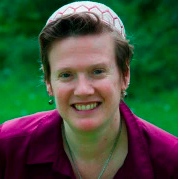
By Rabbi Rachel Barenblat. Translated by Rabbi Juan Mejia.

